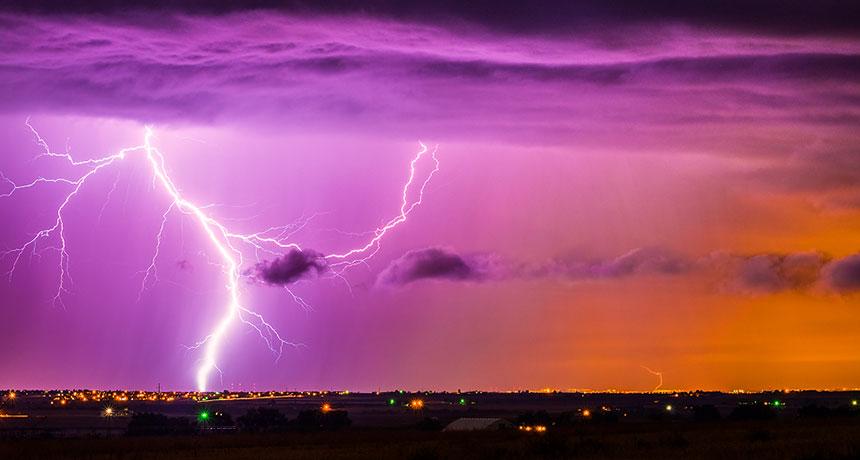Cosmic rays offer clues about lightning
Particles from space provide insights into the electric charges in thunderclouds

Lightning illuminates the sky during a storm in Weld County, Colo. Researchers have developed a new technique to expose the conditions inside thunderclouds that lead to lightning strikes.
BRYCE BRADFORD/FLICKR (CC BY-NC-ND 2.0)
By Andrew Grant
Particles from space are helping unlock a mystery on Earth: What causes lightning?
The particles are called cosmic rays. But they aren’t truly rays. Instead, they are very high-energy particles. The explosion of stars creates many of these particles, which are mainly protons.
Traveling at nearly the speed of light, cosmic rays rain down on Earth from all directions. Occasionally they strike atoms in Earth’s atmosphere. This creates a shower of new particles, which are mostly electrons. A specialized observatory based in the Netherlands tracks these showers. Called the Low Frequency Array (LOFAR), this observatory is made up of thousands of small antennas.
Those antennas detect radio waves. The electron shower created by incoming cosmic rays can emit radio waves (a type of electromagnetic radiation).

Pim Schellart and his team published details of this April 24 in Physical Review Letters. Schellart is a radio astronomer at Radboud University in Nijmegen, the Netherlands.
The new research is helping experts study the structure of storm clouds and the strength of electric fields within them. That electric-field buildup is behind lightning. The new cosmic-ray research can help experts understand how thunderclouds build up their tremendous electric fields, says Joseph Dwyer. A physicist, he works at the University of New Hampshire in Durham.
Cosmic rays also may play a role in causing lightning. The particles could carve out paths in the air through which an electric current might travel. That discharge of electricity creates the flash of light seen in lightning.
Schellart’s team wants to test that idea. It plans to compare the timing of cosmic ray showers and lightning strikes.
Power Words
(for more about Power Words, click here)
astronomy The area of science that deals with celestial objects, space and the physical universe as a whole. People who work in this field are called astronomers.
cosmic An adjective that refers to the cosmos — the universe and everything within it.
cosmic rays Very high-energy particles, mostly protons, that bombard Earth from all directions. These particles mostly originate outside our solar system. They are equivalent to the nucleus of an atom. They travel through space at high rates of speed (often close to the speed of light).
electric field A region around a charged particle or object within which a force would be exerted on other charged particles or objects.
electron A negatively charged particle, usually found orbiting the outer regions of an atom; also, the carrier of electricity within solids.
hypothesis A proposed explanation for a phenomenon. In science, a hypothesis is an idea that must be rigorously tested before it is accepted or rejected.
lightning A flash of light triggered by the discharge of electricity that occurs between clouds or between a cloud and something on Earth’s surface. The electrical current can cause a flash heating of the air, which can create a sharp crack of thunder.
magnetic field An area of influence created by certain materials, called magnets, or by the movement of electric charges.
nucleus Plural is nuclei. (in biology) A dense structure present in many cells. Typically a single rounded structure encased within a membrane, the nucleus contains the genetic information. (in astronomy) The rocky body of a comet, sometimes carrying a jacket of ice or frozen gases. (in physics) The central core of an atom, containing most of its mass.
particle A minute amount of something.
physicist A scientist who studies the nature and properties of matter and energy.
proton A subatomic particle that is one of the basic building blocks of the atoms that make up matter. Protons belong to the family of particles known as hadrons.
radio waves Waves in a part of the electromagnetic spectrum; they are a type that people now use for long-distance communication. Longer than the waves of visible light, radio waves are used to transmit radio and television signals; it is also used in radar.







